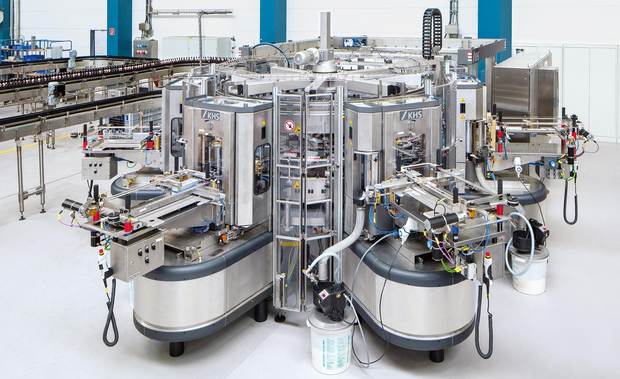Professor Lehmann, after the invention of the power loom, the assembly line and programmable logic controllers, with the Internet of Things comes the fourth biggest change. What are the key features of Industry 4.0 in production? The Industry 4.0 future project, initiated four years ago, aims to integrate customers and business partners more strongly into business and value creation processes. It’s also about the economical and cost-effective manufacture of individualized products which are based on standards.
What does this mean exactly?
The central production control systems used to date aren’t flexible enough to meet future demands. They won’t be able to satisfy the requirement for more variance and the biggest possible degree of individuality. Industry 4.0 thus focuses on decentralized systems and the Web-supported networking of all areas which contribute to the creation of value.
Is Industry 4.0 a revolution?
You can often only tell if something is or was a revolution in retrospect. One example is the process control computer which emerged in the 1970s during the course of the third industrial or digital revolution. It took quite a while before it was able to optimize processes. This is also how I see it now. To me, Industry 4.0 is therefore more of an evolution, with new technologies which are gradually being introduced.
What does this look like in practice?
In the digital production world of the Smart Factory, with networked machines which communicate with one another, it all starts with the products. These automatically select the production process which suits them. The aim is to produce a batch size of one for a price similar to that for batches manufactured in serial or mass production. In an optimum process energy and resource savings are also possible, which means that production becomes more sustainable.
“The aim is to produce a batch size of one for the price of serial or mass production.”
What’s the difference compared to the CAD/CAM programs for computer-aided design and manufacture introduced in the past?
The C technologies were isolated solutions which were designed to be linked into computer-integrated manufacturing or CIM processes at a later stage. The aim was to consistently automate everything from the design engineering department to production. However, at that time the networks weren’t yet sufficiently developed and there was no fast communication through an Intranet or the Internet. Computer speeds and storage capacities were also relatively low. In addition, knowledge of IT is now much more widespread among the population and the younger generation in particular is very adept at using IT applications.
For some, the technological transition to the Smart Factory still sounds like something out of a science fiction movie. Where are we in this process at the moment and how can we envisage industrial manufacturing in the future?
We can probably expect to see the first cases where Industry 4.0 is consistently implemented, with fully dovetailed production and business processes, in about 20 years from now. Regarding intelligent networking and the creation of a Smart Factory for the economical production of an optimum batch size of one, this process has already begun, however. This is demonstrated by the increased use of embedded systems: small, intelligent systems with full computer power mounted on a single chip. They form the basis of cyber-physical production systems. In these, computational software components communicate with mechanical and electronic parts over the Internet. Another key component is RFID technology, with which objects can be automatically identified and located using transmitter and receiver systems. These are used in particular to access workpiece data and provide digital information on ordering processes and production paths. With this, people in the factory know where all the parts needed for a production batch are at all times.
Where is the greatest potential for introducing Industry 4.0 and what are the opportunities here?
In the individualization of consumer products. Examples include sports shoes, where you can stipulate which design, color and type of lacing you’d like, and photo albums, which are creatively designed by customers from a type of tool box according to their own ideas and wishes.
Industry 4.0 shows its strength where the aim is to involve the customer and improve products. Manufacturers glean important information from customers as to where a product is good or where there’s room for improvement. Involving customers largely contributes to making production suitably market oriented. Industry 4.0 also generates strong momentum for new avenues of sale over the Internet. Physical transportation was and still is a matter of transport logistics.
“Current studies reckon on Industry 4.0 bringing about an increase in economic efficiency of around 30%.”
How secure are the IT and data when using the Internet of Things in industry?
Here, too, there are a number of other interesting developments besides the software solutions many of us know about. A hardware manufacturer may try to improve security on a hardware level, for example. Introducing encryption at this level has the advantage that it’s much more difficult for would-be intruders to hack into the system.
What can Industry 4.0 offer machine and system manufacturers and how does the Smart Factory affect the organization and processes within a company?
Current studies reckon on Industry 4.0 bringing about an increase in economic efficiency of around 30%. This is a very strong argument for entrepreneurs who are always looking to secure cost benefits and market advantages. Intelligent production also gives them great flexibility and relies on flat hierarchies. In my view, the personal commitment of company directors and a concrete target are highly significant when it comes to successful implementation. There definitely appears to be a willingness to study this topic more intensively. In a survey made by McKinsey, for instance, over 90% of the decision-makers questioned in Germany, Japan and the USA declared that they see the digitization of industrial production as an opportunity.
Industry 4.0 may have its technological roots in information and communication technology (ICT) but ultimately it will have to be implemented in an industrial manufacturing environment. What will be required of production personnel in the future and how will their jobs change?
Personnel with a knowledge of mechanical engineering, electronics and IT will be needed. New professional profiles will emerge from this, where expertise from all three fields will be more strongly combined than ever before. A skilled worker on the production line will then have comprehensive, detailed knowledge of the product and how it’s made, for example. When the working environment changes with Industry 4.0, after suitable training these employees can take on a role as supervisor and responsibility for several manufacturing cells. They would then be less involved in the actual manufacture of the product and instead would be more engaged in controlling and monitoring processes. In this role they would also communicate directly with their machines, among other tasks – either using a tablet PC or, even simpler, by talking, familiar to us through the electronic language assistants on our smartphones.
It’s therefore important to keep people involved and invest in their basic and further training.
It certainly is. And there are many approaches to suitable modes of training for Industry 4.0. These also include the combined courses of study we offer company personnel, for instance. E-learning and multimedia are also used intensively for basic and further training activities, as are Internet conferences and learning platforms with online courses. Innovative virtual or augmented reality tools are also opening up completely new avenues in interactive learning. Not only areas closely related to production are profiting from these.
How do customers perceive the changes brought about by intelligent production? What benefits does the world of digital production give them?
The consumer will increasingly profit from individual products which are still cost effective and which can be ordered on the Internet and delivered quickly. The spectrum of customized products like these already ranges from individually ‘designed’ muesli and chocolates to personal perfumes and t-shirts. The opportunities offered by the Smart Factory and short shipping distances also enable delivery times to be shortened even further. For example, a new car with all the required extra equipment could be standing outside the customer’s house in about half the time it does today.
Where do you see exemplary starting points for the KHS Group with Industry 4.0?
At this year’s trade show in Hanover, the Hannover Messe, which was dedicated to the motto of Industry 4.0, KHS already presented one result from its CyberSystemConnector research project: the model of a system which can print PET bottles in series with an individual dressing. I could imagine further systems here: for example, a bottle with an integrated RFID antenna. This signals to the system that it has to be filled with a beverage with a certain flavor. The bottle would then independently make its way through the filling system and enter the right conveyor segment for the required product. It would also be beneficial in the interests of sustainability if the bottle were to do without a label to save resources and be printed using the NMP Direct Print method.
Professor Lehmann, many thanks for your comments and this interesting interview.
The interview was conducted by Jörg Michael Pläsker.
Your contact on this topic
Christian Wopen
Press and Public Relations
Phone: +49 251 62 55 61 21
Email: wopen@sputnik-agentur.de

























